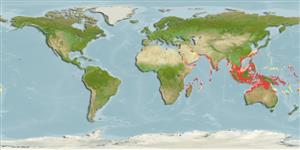Preferred temperature (Ref.
115969): 25.3 - 28.6, mean 27.6 (based on 746 cells).
Phylogenetic diversity index (Ref.
82804): PD
50 = 1.5000 [Uniqueness, from 0.5 = low to 2.0 = high].
Bayesian length-weight: a=0.01288 (0.00921 - 0.01802), b=2.94 (2.85 - 3.03), in cm Total Length, based on LWR estimates for this species (Ref.
93245).
Trophic level (Ref.
69278): 4.2 ±0.7 se; based on diet studies.
Resilience (Ref.
120179): High, minimum population doubling time less than 15 months (K=0.6).
Prior r = 0.75, 95% CL = 0.49 - 1.12, Based on 5 data-limited stock assessments.
Fishing Vulnerability (Ref.
59153): Low vulnerability (21 of 100).
Climate Vulnerability (Ref.
125649): High vulnerability (65 of 100).
